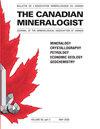Cathodoluminescence and trace-element chemistry of quartz from Sudbury offset dikes: Observations, interpretations, and genetic implications
IF 1.5
4区 地球科学
Q3 MINERALOGY
引用次数: 2
Abstract
Offset dikes, radial and concentric fractures infilled with quartz diorite, are important hosts of Ni-Cu-PGE mineralization in the Sudbury area. To better understand their emplacement and evolution, the cathodoluminescence (CL) and trace-element chemistry of quartz were examined in quartz diorite from the Foy, Trill, Whistle, Hess, Parkin (North Range), and Copper Cliff (South Range) offsets. Although the potential causes of the CL response in quartz are considered, the primary focus was the qualitative textures and patterns, as these can provide valuable paragenetic information. Quartz from the North Range displays a strong blue luminescence dominated by homogenous and sharply zoned CL patterns, while that from the Copper Cliff offset displays a weak CL response. Locally recrystallized granoblastic quartz shows diffuse concentric zoning and other heterogeneous CL patterns. Trace-element EPMA-WDS analyses indicate that quartz from the Foy, Trill, and Whistle offsets is enriched in Al (30–600 ppm) and Ti (50–520 ppm) as compared to Fe (<25–490 ppm), while quartz from the Parkin and Hess offsets is enriched in Fe (270–700 ppm) as compared to Ti (44–211 ppm) and Al (95–250 ppm). In contrast to the North Range offsets, quartz from Copper Cliff has low Al concentrations (30–85 ppm) and very low Ti concentrations (<25 ppm). Application of the Ti-in-quartz geothermometer indicates that quartz from the North Range offsets crystallized above 600 °C, while that from the Copper Cliff offset crystallized below 600 °C. The CL responses and trace-element compositions of anhedral quartz from the North Range offsets are consistent with primary crystallization of quartz from magmatic quartz diorite, while those of the granoblastic quartz record dynamic recrystallization and Ostwald ripening. Copper Cliff quartz is anomalous in its CL response, trace-element content, and crystallization temperature, which may reflect overprinting during regional metamorphism of the South Range of the Sudbury Igneous Complex. Quartz CL is demonstrated to be an important tool for discerning and discriminating between paragenetic processes related to the formation of the offset dikes and has clear applications to the study of other quartz-bearing igneous rocks in the Sudbury area.萨德伯里偏移岩脉中石英的阴极发光和微量元素化学:观察、解释和成因意义
含石英闪长岩的偏置岩脉、径向和同心裂缝是萨德伯里地区镍铜铅矿化的重要寄主。为了更好地了解它们的就位和演化过程,对北山脉Foy、Trill、Whistle、Hess、Parkin和南山脉Copper Cliff的石英闪长岩进行了阴极发光(CL)和微量元素化学分析。虽然考虑了石英中CL响应的潜在原因,但主要焦点是定性结构和模式,因为它们可以提供有价值的共生信息。北岭石英表现出强烈的蓝色发光,以均匀的、明显分带的CL模式为主,而铜崖偏移则表现出微弱的CL响应。局部重结晶的花岗砾岩石英表现为弥漫性同心分带和其他非均质CL模式。微量元素EPMA-WDS分析表明,与铁(< 25-490 ppm)相比,Foy、Trill和Whistle偏置的石英富含Al (30-600 ppm)和Ti (50-520 ppm),而Parkin和Hess偏置的石英富含Fe (270-700 ppm),而Ti (44-211 ppm)和Al (95-250 ppm)。与North Range偏移相反,铜崖石英具有低铝浓度(30-85 ppm)和非常低的钛浓度(<25 ppm)。ti -in-石英地温计的应用表明,来自North Range偏移的石英在600℃以上结晶,而来自Copper Cliff偏移的石英在600℃以下结晶。北岭偏置菱形石英的CL响应和微量元素组成与岩浆岩石英闪长岩石英的原生结晶一致,而花岗石英的CL响应和微量元素组成记录了动态再结晶和奥斯特瓦尔德成熟。铜崖石英在CL响应、微量元素含量、结晶温度等方面异常,可能反映了萨德伯里火成岩杂岩南段区域变质过程中的套印作用。石英CL被证明是识别和区分与偏移岩脉形成有关的共生过程的重要工具,在研究萨德伯里地区其他含石英火成岩方面具有明显的应用价值。
本文章由计算机程序翻译,如有差异,请以英文原文为准。
求助全文
约1分钟内获得全文
求助全文
来源期刊

Canadian Mineralogist
地学-矿物学
CiteScore
2.20
自引率
22.20%
发文量
45
审稿时长
4-8 weeks
期刊介绍:
Since 1962, The Canadian Mineralogist has published papers dealing with all aspects of mineralogy, crystallography, petrology, economic geology, geochemistry, and applied mineralogy.
 求助内容:
求助内容: 应助结果提醒方式:
应助结果提醒方式:


